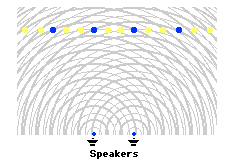Waves, Sound and Light: Light Waves
Light Waves: Audio Guided Solution
Problem Set LW7, Question 7:
A physics teacher is using two audio speakers to demonstrate sound interference. The speakers are located 4.34 meters apart and playing a frequency of 446 Hertz. (Assume a speed of sound of 345 m/s.) Students are sitting in seats in the same row in an auditorium. The seats are spaced 116.2 centimeters apart and every third student is sitting in a position of destructive interference. What is the perpendicular distance (in meters) from the row of students to the line connecting the speakers?

Audio Guided Solution
Habits of an Effective Problem Solver
An effective problem solver by habit approaches a physics problem in a manner that reflects a collection of disciplined habits. To be an effective problem-solver...
- ... read the problem carefully and develop a mental picture of the physical situation. If necessary, sketch a simple diagram of the physical situation to help you visualize it.
- ... identify the known and unknown quantities and record them in an organized manne; often times, they can be recorded on the diagram itself. Equate given values to the symbols used to represent the corresponding quantity (e.g., v = 3.00x108 m/s, λ = 554 nm, f = ???).
- ... use physics formulas and conceptual reasoning to plot a strategy for solving for the unknown quantity.
- ... identify the appropriate formula(s) to use.
- ... perform substitutions and algebraic manipulations in order to solve for the unknown quantity.
Read About It!
The following pages from The Physics Classroom Tutorial may serve to be useful in assisting you in the understanding of the concepts and mathematics associated with these problems.
Return to Original Problem Set
Return to Index of Extra Problems
Return to Overview